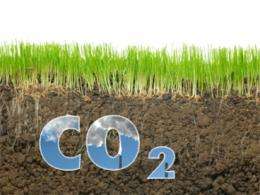Figuring out where to put the carbon

(�鶹��ԺOrg.com) -- To meet our immediate energy needs without exacerbating climate change, most experts agree, we’ll need to find a way to store the carbon dioxide given off by the combustion of coal, oil and natural gas. But no full-scale storage systems exist, and the plans to create them have many unknowns.
New projects at MIT could help to fill that information gap. At the American Geophysical Union’s fall meeting last month in San Francisco, two teams explained how they are addressing some of the uncertainties over carbon capture and sequestration (CCS). Many scientists view CCS as a promising way to dramatically reduce the amount of CO2 emitted into the atmosphere.
Carbon capture refers to separating out a stream of concentrated carbon dioxide from the rest of the gases and particles given off by fossil fuel combustion. Sequestration involves disposing of that CO2 by pumping it deep underground or beneath the oceans, or converting it into solid form for disposal (or use) on land. The AGU presentations from MIT dealt with underground sequestration.
One MIT group presented methods for using computer simulation to analyze the potential of specific sites to pump CO2 underground. Another group proposed an integrated system for monitoring such sites once they’re in use. Between them, the MIT presentations covered the spectrum of carbon sequestration, from the initial proposal through the life cycle of such sites.
It’s important to prepare for the unexpected, since breaches of the sites could be dangerous or even fatal. For example, a sudden release of carbon dioxide from an underground storage site could asphyxiate the people in that area — something that has occasionally happened near natural reservoirs of the gas.
Ruben Juanes, the ARCO assistant professor in energy studies, proposed a new mathematical model for estimating the storage capacity of possible CO2 sequestration areas. Juanes’ model can be applied to sites as large as geologic basins, which can span hundreds of kilometers. The tool, which Juanes developed with the help of graduate students Christopher MacMinn and Michael Szulczewski, could be used to estimate the potential underground CO2 storage space across the entire United States.
Such estimates are complicated because there are several different mechanisms by which the CO2 can spread out from the point where it is released underground, and additional mechanisms that allow it to eventually become trapped. The spreading can occur by natural groundwater flows or by migration upward along a sloping aquifer, and the trapping can be caused by the CO2 dissolving in the water in deep aquifers, or by seeping through capillary action into cracks in the rock.
Juanes said his system accounts for all of the major known mechanisms by which carbon dioxide can get trapped in these underground formations. But for future research, he added, “The key uncertainty is the potential migration of CO2 vertically across geologic layers.” For instance, the pressure of the injected CO2 might produce faults and fractures in the rock, and this could create pathways to the surface and into the atmosphere. Juanes says his team is now working to better understand this potential mechanism.
Jerome Neufeld, a research fellow in the Institute of Theoretical Geophysics at the University of Cambridge who specializes in the fluid dynamics of carbon dioxide sequestration, says the tools developed by Juanes and his associates “provide a starting point to more robust estimates of the propagation of CO2 plumes as well as the magnitude of trapping mechanisms.”
If and when such capture and sequestration systems are actually put into operation, close monitoring will be essential. That’s where another MIT team, led by Carolyn Seto, the Clare Boothe Luce Postdoctoral Fellow, comes in. Seto, working with graduate student Arman Haidari and Gregory McRae, the Hoyt C. Hottel Professor of Chemical Engineering, Emeritus, used predictive simulations to develop a monitoring system for a sequestration site, integrating information from networks of sensors to infer the amounts and locations of the injected CO2 as it moves through underground formations.
To monitor the sites adequately but without undue costs, the team looked into the minimum number and type of monitoring stations that would be needed. To do this, they would measure tiny deformations in the surface topography, monitor gases escaping from the soil, test geochemical samples from observation wells, and monitor seismic activity.
Because of the potential risks from sequestered CO2 being released to the surface, as well as other risks such as groundwater contamination or geomechanical effects (including possible increased earthquake risks in some locations), constant monitoring of the site “serves as an early warning mechanism if there are anomalies in the project, allowing us to locate the CO2 and intervene, should it be necessary,” Seto says.
Because large-scale sequestration would involve orders of magnitude greater injection of CO2 underground than has been attempted before, and would likely encompass a variety of geological formations and surface environments and would continue for decades, Seto says, “some monitoring techniques may be more appropriate than others at specific times in the life cycle of the sequestration project and in certain environments.” This research was “intended to provide guidance to policy makers, highlighting the trade-offs between costs and detection limits which must be considered when implementing a monitoring program.”
If fully implemented, CO2 sequestration could ultimately involve the injection of billions of tons of carbon dioxide underground every year. But that potential depends on resolving the remaining uncertainties, and these analyses provide useful tools to help meet that need.
As Neufeld says, “the importance of such tools is critical to a quantitative assessment of the large-scale feasibility of carbon sequestration.”
Provided by Massachusetts Institute of Technology














